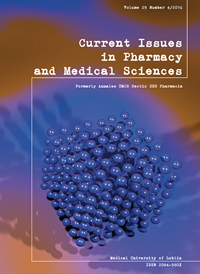The influence of renin angiotensin aldosterone system blockers on asymmetric dimethylarginine levels in patients with chronic glomerulonephritis
DOI:
https://doi.org/10.1515/cipms-2016-0038Keywords:
asymmetric dimethylarginine, proteinuria, renin angiotensin aldosterone systemAbstract
Endothelial dysfunction could be related to the limited availability of nitric oxide (NO). NO is synthesized with the participation of an NO synthase whose activity is inhibited by asymmetric dimethylarginine (ADMA). The synthesis of ADMA is exacerbated by oxidative stress, and several studies have shown the efficacy of drugs acting on the renin-angiotensin-aldosterone system (RAAS) (converting enzyme inhibitors and angiotensin II receptor antagonists) in reducing the level of ADMA. The probable mechanism of drug action is a reduction of oxidative stress through a decrease of angiotensin II formation. The aim of this study was to assess the influence of RAAS blockers on the plasma concentration of ADMA in patients with chronic glomerulonephritis (ChGN). The study included 37 patients, placed into group A and group B, depending on the treatment. Both groups were treated with RAAS blockers. In group B, immunosuppressive drugs were additionally administered. The control visits were at the 0, 6 and 12 months of observation. In both the studied groups (A+B), a significant reduction of ADMA (0.77 vs 0.4 μmol/l; p<0.05) was noticed. In patients suffering from ChGN, the use of RAAS blockers resulted in a significant decrease of plasma ADMA concentration, independently of immunosupressive treatment.References
1. Bonetti P.O., Lerman L.O., Lerman A. Endothelial dysfunction: a marker of atherosclerotic risk. Arterioscler Thromb Vasc Biol., 23,168-175, 2003. [Crossref]
2. Böger R.H. et al. Asymmetric Dimethylarginine (ADMA): A Novel Risk Factor for Endothelial Dysfunction, Its Role in Hypercholesterolemia. Circulation, 98, 1842-1847, 1998.
3. Caglar K. et al. ADMA, proteinuria, and insulin resistance in non-diabetic stage I chronic kidney disease. Kidney Int., 70, 781-787, 2006.
4. Colonna De Gennaro V. et al. Asymmetric dimethylarginine (ADMA): an endogenous inhibitor of nitric oxide synthase and a novel cardiovascular risk molecule. Med Sci Monit., 15, RA91-101, 2009.
5. Deckert T., Feldt-Rasmussen B., Borch-Johnsen K. Albuminuria reflects widespread vascular damage. The Steno hypothesis. Diabetologia, 32, 219-226, 1989. [Crossref]
6. Fliser D. et al. Asymmetric dimethylarginine and progression of chronic kidney disease: the mild to moderate kidney disease study. J Am Soc Nephrol., 16, 2456-2461, 2005. [Crossref]
7. Fujii H. et al. Renin-Angiotensin System Inhibitors Reduce Serum Asymmetric Dimethylarginin Levels and Oxidative Stress in Normotensive Patients with Chronic Kidney Disease. Nephron Extra, 4, 18-25, 2014. [Crossref]
8. Fujimi-Hayashida A. et a l. Association of asymmetric dimethylarginine with severity of kidney injury and decline in kidney function in IgA nephropathy. Am J Nephrol., 33,1-6,2011. [Crossref] [Web of Science]
9. Hibbs J.B., Vavrin Z., Taintor R.R. L-Arginine is required for expression of the activated macrophage effector mechanism causing selective metabolic inhibition in target cells. J Immunol.,138: 550-565,1987.
10. Makino H. et al. INNOVATION Study Group: Prevention of transition from incipient to overt nephropathy with telmisartan in patients with type 2 diabetes. Diabetes Care, 30, 1577-1578, 2007.
11. Paisley K.E. et al. Endothelial dysfunction and inflammation in asymptomatic proteinuria. Kidney Int., 63, 624-633, 2003.
12. Ruggenenti P. et al. Reno-protective properties of ACE-inhibition in non-diabetic nephropathies with non-nephrotic proteinuria. Lancet, 354, 359-364, 1999.
13. Stehouwer C.D. et al. Microalbuminuria is associated with impaired brachial artery, flow-mediated vasodilation in elderly individuals without and with diabetes: further evidence for a link between microalbuminuria and endothelial dysfunction – the Hoorn Study. Kidney Int., 92, S42-S44, 2004.
14. Webb N.J. et al. Randomized, double-blind, controlled study of losartan in children with proteinuria. Clin J Am Soc Nephrol., 5, 417-424, 2010. [Web of Science] [Crossref]
15. Zoccali C., Kielstein J.T. Asymetric dimethylarginine: A new player in the pathogenesis of renal disease? Curr Opin Nephrol Hypertens, 15, 314-320, 2006. [Crossref]
Downloads
Published
Issue
Section
License
Copyright (c) 2017 Authors

This work is licensed under a Creative Commons Attribution-NonCommercial-NoDerivatives 3.0 Unported License.


